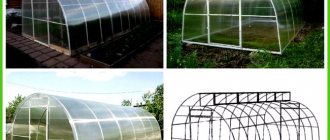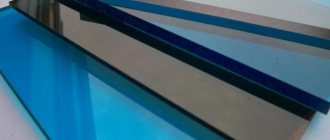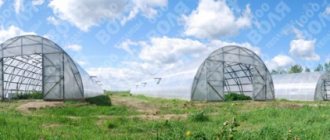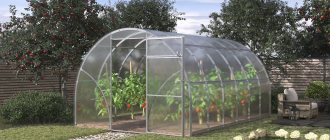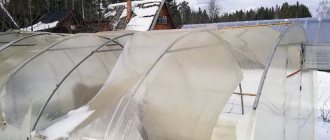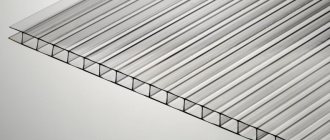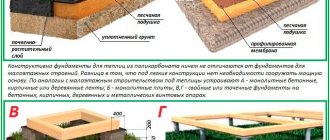Polycarbonate for a greenhouse – which is better, what to look for and why plastic. You will learn the answers from this article. You will become familiar with the benefits of polycarbonate, characteristics and popular manufacturers.
The greenhouse can be used to grow vegetables and dwarf trees depending on the size. It can also be decorative at the same time. Source happymodern.ru
Polycarbonate is a modern and lightweight material that easily withstands the negative effects of UV filters, lasts a very long time and helps maintain an optimal microclimate. Therefore, it is widely used to develop designs for growing various plants.
Advantages of polycarbonate
Plastic is widely used both in private plots and on farms. It surpasses glass and film in the most important parameters. Today you can purchase polycarbonate sheets separately or buy a ready-made greenhouse.
The main advantage of the material is its structure. For greenhouses, only cellular plastic is used. Monolithic slabs do not have the necessary properties and are heavier. How to choose high-quality polycarbonate - you need to remember the following: each sheet can consist of two or three parallel plates, they are connected to each other by jumpers, which act as stiffeners. Air remains in the resulting space, increasing the thermal insulation characteristics. The structure can have a different number of chambers. There are also sheets of different colors.
Polycarbonate sheets with square and double (reinforced) rectangular honeycomb shapes in thicknesses of 4, 6 and 8 millimeters. Source ulitka.kharkov.ua
Main advantages:
- is not afraid of the negative influence of mold, temperature changes, withstands gusts of wind, and can resist the spread of fire;
- high levels of noise insulation;
- the honeycomb structure provides thermal insulation properties, reducing the cost of heating the greenhouse;
- the sheets have fairly good strength, do not burst or shatter into dangerous fragments, this indicator increases with the thickness of the sheets;
- polycarbonate is quite flexible and can be bent to create an arch;
- very light sheets, therefore the load on the greenhouse structure is significantly reduced;
- high transparency, rays are scattered around the entire perimeter, colorless litas can transmit more than 90% of light, a special coating protects plants from UV;
- Another important advantage of polycarbonate is durability; with proper installation of the material, sheets can last more than 10 years.
The only drawback is the rapid destruction of plastic without a protective layer by sunlight. To avoid this problem, you need to purchase sheets with a protective coating. The constructed greenhouse will last a long time, but only if high-quality materials are used.
The greenhouse can be heated using various methods (gas, wood, electricity); special phytolamps are used for artificial lighting. Source nashgazon.com
About plastic sizes and main points
Very thick plastic is not recommended. This is impractical and leads to unnecessary costs. It is recommended to use panels of minimum to medium thickness. Which polycarbonate to choose for a greenhouse, 4 or 6 mm, must be determined in accordance with the design used and the climate.
The width of all sheets is always standard, it is 2.1 m. The length can be 6 or 12 m. Manufacturers allow a slight deviation, which is measured in millimeters. There is a much larger choice in thickness: the minimum is 4 mm, and the maximum is 16 mm.
It is necessary to take into account the features of panels when working with plastic :
- when developing gable roofs, the sheets must be divided without residue;
- plastic joints must fall on the profile;
- when creating arches, the length of the arcs is 6 or 12 m;
- There should be no transverse joints.
It is important to remember that depending on the ambient temperature, plastic can expand or contract. It is very important to take this into account when attaching panels and always leave gaps.
Polycarbonate is installed using special fasteners. Source miremonta.ru
Sheet thickness
How to choose polycarbonate for a greenhouse based on sheet thickness, because this is a very important indicator. There are many factors that must be taken into account so that the material is neither thick nor thin, harmoniously provides good light transmittance and guarantees sufficient strength.
Parameter Definition:
- design - greenhouses come in different roof shapes, so you need to determine the level of bending in advance; the smaller the thickness, the greater the level of bending;
- seasonality - thin sheets are suitable for the warm season, thick models are used for year-round use, they retain heat, withstand strong winds and fairly large accumulation of snow;
- lathing - the distribution step of structural elements affects the permissible thickness of the sheets, and also directly affects the overall strength of the structure;
Feedstock for polycarbonate
Polycarbonate for greenhouses is a plastic polymer that is in granules, but after processing it takes on its final form. In addition to the granules themselves, the raw materials include:
- carbonic acid;
- solvents;
- diatomic phenol;
- water.
As a result of the processing and synthesis of phenol, polycarbonate is obtained. In its natural form it is transparent or has a slightly yellow tint. In order to obtain colored polycarbonate, dyes are added to the raw material.
Important! In manufacturing, the term "polycarbonate" is shortened to PC or PC.
Pros and cons of polycarbonate for greenhouses
Polycarbonate used for the construction of greenhouses has many advantages. In addition to its good ability to transmit light, due to its transparency it is light in weight and has a number of other advantages:
- excellent ability to retain heat;
- good gas permeability;
- high flexibility, raw materials suitable for creating arched structures;
- long service life, more than 10 years;
- high strength, some monolithic types are bulletproof;
- good resistance to mechanical damage.
In addition, polycarbonate for greenhouses retains ultraviolet rays and does not lose its properties at high temperatures, even if its surface is heated to +60°C. The raw materials are completely environmentally friendly and have low cost.
However, polycarbonate also has disadvantages. Raw materials are unstable to chemicals and deteriorate when exposed to ethyl alcohol, varnishes, kerosene or gasoline, ammonia, and all kinds of solvents. With prolonged contact with the listed substances, cracks appear and the sheets become deformed. That is why it is necessary to take care of such coating in greenhouses very carefully.
Warning! All cleaning products must not contain aggressive chemical compounds.
Short story
Polycarbonate is a plastic based on polymer raw materials. Interestingly, the substance itself was obtained in 1953, almost simultaneously in the German and American General Electric.
Industrial production of raw materials dates back to the late sixties of the twentieth century. But sheet cellular polycarbonate was first manufactured in Israel, two decades later.
The material had unique qualities:
- Transparency;
- Strength;
- Flexibility;
- High thermal insulation characteristics;
- Ease;
- Easy installation;
- Resistance to temperature changes;
- Safety;
- Chemical resistance;
- Environmentally friendly.
The remarkable combination of technical characteristics of this polymer material is the reason for its popularity. Its scope is wide, and in private households it has become a favorite material for covering greenhouses.
Types of polycarbonate
Several types of polycarbonate are used for the construction of greenhouses:
- Monolithic - a transparent solid sheet with a smooth surface.
- Cellular - has a structure with hollow cells and partitions between them.
- Profiled - the surface of the sheet is corrugated, wavy or corrugated.
The release form of standard polycarbonate is a sheet of certain sizes. According to reviews from experienced summer residents, the best polycarbonate for making greenhouses is cellular. It retains heat well due to its cellular structure and has the necessary rigidity to withstand wind and snow.
Type
In conclusion, let’s talk about the types of polycarbonate used for greenhouses. A total of 3 types are used:
- Cellular
- Monolithic profiled
- Monolithic smooth
In the vast majority of cases in Russia, SPK is used for greenhouses. However, profiled is sometimes used, for example, if transparency is extremely important, or for a light summer greenhouse option. We almost never use monolithic smooth.
Greenhouse made of profiled polycarbonate
We briefly looked at what polycarbonate should be for a greenhouse, and we hope that this article will help you make your choice.
Which polycarbonate is better to choose for a greenhouse?
The strength and durability of the greenhouse depends on the quality of polycarbonate, so it needs to be selected correctly. The structure of the cells and their density, as well as their ability to withstand ultraviolet radiation, play an important role.
How to choose polycarbonate for a greenhouse by density
The strength of the cells depends on their shape and partition options. Modern polycarbonate for greenhouses is made with rectangular, square or hexagonal cells. The best among brands is a German company. It produces the strongest hexagonal cell PC, which can be used to create winter greenhouses. However, the level of light transmission of such a sheet is the lowest. It is not recommended to grow plants in such a greenhouse without additional lighting.
The cheapest and lightest is cellular polycarbonate with rectangular cells. It has good light transmittance, but low strength.
Sheets with square cells are more durable and transmit light well. They are excellent for the construction of greenhouses for spring and summer purposes.
More details on how to choose the right cellular polycarbonate for a greenhouse are shown in the video.
The cell structure is closely related to the PC density. Sheets with rectangular partitions have a density of 0.52 to 0.60 g/cm³. The density of square cells reaches 77 g/cm³. The highest density, respectively, is for hexagonal polycarbonate, it is equal to 82 g/cm³.
What thickness of polycarbonate is best to use for a greenhouse?
The thickness of polycarbonate is the main factor by which you can choose the right material for a greenhouse. You need to make sure that the sheet is not too thin or thick. Otherwise, the structural strength and light transmittance are reduced. The optimal thickness of a cellular PC for a greenhouse ranges from 4 to 8 mm. The latter is too dense, more suitable for winter construction, and does not transmit light well.
To decide which polycarbonate is better, you need to take into account the type of greenhouse, the shape of the roof and many other factors:
- The climate of the area, the amount of snow and its weight. The maximum load on the structure will depend on this.
- The direction of winds in the region and their strength.
- Greenhouse frame material. Metal structures are more stable and can withstand greater loads. A wooden frame has less load-bearing capacity.
- The distance between the frame sheathing. The closer the supporting elements of a structure are attached, the stronger it becomes. You can cover the greenhouse with less dense PC.
- Seasonality of plantings. If the room will be used only in the spring and summer, then there is no need to use a PC that is too thick. For industrial year-round cultivation, greenhouses are built from denser polycarbonate.
Based on these data, it can be determined that for most regions, greenhouses are made of polycarbonate with a density of 6 mm. You can plant vegetables in it throughout the spring and summer season. For the winter version, choose thicker sheets, about 8-10 mm.
Polycarbonate with a thickness of 4 mm can be called an economical option. Structures with such a coating are used only for domestic needs. They are not suitable for industrial cultivation, since they do not withstand snow and wind loads well, do not retain heat, and after a thaw an ice crust forms on the walls.
With or without UV protection
Polycarbonate itself is destroyed by ultraviolet rays. Therefore, it is better to cover the greenhouse with sheets with additional protection. It protects not only the material from ultraviolet radiation, but also plants that are harmful to hard radiation.
Modern manufacturers, when processing a sheet, cover it with a thin film that does not peel off during operation. This is the kind of polycarbonate that will last for decades and retain its strength.
Important! When installing the structure, the covering layer is installed outward.
If you choose a Chinese PC without additional protection or with a thin layer, you should not count on a long service life. Maximum 2-3 years, after which the material needs to be replaced.
Information about the protective coating on polycarbonate is indicated in special documents. It is impossible to determine its presence by eye.
What color polycarbonate is best to use for a greenhouse?
In stores you can see colored polycarbonate in different shades. Many people advise covering greenhouses with red and orange PC, arguing that this spectrum of rays is the most favorable for plants. However, it is worth understanding that the light transmittance of the material is low. It conducts no more than 40-60% of the rays, which is very little for the normal development of crops. There is no need to talk about large harvests.
To cover greenhouses, summer residents choose transparent polycarbonate. It transmits light well, all life processes of plants proceed as they should.
General characteristics of the material
The general technical properties of both types of polycarbonate include the following parameters:
- density - from 1.2 g/cm (ISO 1183);
- light transmittance (on a transparent sample) - from 86% (DIN 5036);
- impact strength (on a notched sample) - from 10 kJ/m (ISO 179);
- tensile strength - from 60 MPa (ISO 527);
- tensile elasticity - from 2000 MPa (ISO 527);
- relative elongation - from 80% (ISO 527):
- softening temperatures - from 145°C (ISO 306);
- decomposition temperatures - from 280°C;
- maximum short-term temperature - from 130°C;
- maximum long-term temperature - from 115°C.
How to choose high-quality polycarbonate for a greenhouse
So, knowing all the characteristics of polycarbonate, before purchasing you need to decide which one to choose for building a greenhouse. Reinforced sheets are useful for permanent structures in regions with difficult weather conditions, where vegetables will be grown all year round. Such a PC must withstand snow loads. In other areas, you can choose simpler and cheaper options.
You can measure the thickness of the purchased sheet using a caliper. If there are deviations from the standards, then it is better to refrain from purchasing such a PC. Its quality is questionable.
The presence of ultraviolet protection can be determined not only in documents. The thin protective film contains markings indicating which side of the PC will face the sun.
To make a greenhouse you need to buy the best cellular polycarbonate. After all, cheap materials are produced from recycled materials or with manufacturing irregularities. They will not make a quality greenhouse. The service life of PC sheets is no more than 2-5 years.
It is important to understand that little-known companies that no one on the market has heard of are unlikely to offer anything worthwhile. It is better to choose polycarbonate from well-known brands for the greenhouse. They are interested in their reputation.
Customer reviews from the forum
– Never in my life will I buy a lightweight version of polycarbonate again. The coating failed without lasting even three years! It couldn't withstand even a moderate gust of wind. No, it’s better to take more durable material for the greenhouse.
Oscar, Vladivostok
– When I needed to prepare a greenhouse, a friend advised me to buy Carbonglass plates, she said they were of good quality. You know, I'm happy. The greenhouse has been serving me for three years now, and the polycarbonate looks like new. I hope it will last for 10 years.
Veronica, Ryazan
– Of course, for a greenhouse you need to buy polycarbonate at least 6 mm thick. 8 mm sheets are also good, but it seems to me that they transmit light worse, especially colored ones. I bought transparent ones for the greenhouse and matte ones for the gazebo. Colored ones for various decorative elements, design, canopies are just right, but in greenhouses and greenhouses there is no need for extra darkening.
Yuri, Tyumen
How to prepare a polycarbonate greenhouse for winter
Rating and comparison of polycarbonate manufacturers
Today there are many brands on the building materials market that can offer quality at an affordable price. You can choose the appropriate polycarbonate for the greenhouse or order custom-sized sheets. In the ranking table, the leading positions are occupied by those whose products are the most in demand.
| Trademark | Product Description |
| "Trirex" | A company from Korea produces inexpensive but high-quality cellular PCs |
| "Polygal" | Durable, wear-resistant and affordable material from a Russian company |
| "Carboglass" | Premium sheets at an affordable price from a domestic manufacturer. PC service life – more than 15 years |
| "Plastilux" | Chinese PC at an affordable price and acceptable quality |
| "Vizor" | Chinese PC of average quality. Sheet service life is just over 5 years |
More expensive and high-quality cellular polycarbonate is produced by foreign companies. It is suitable for the construction of industrial greenhouses. The table shows the ranking of the most famous brands.
| Name | Description of material |
| Makrolon from Bayer Material Science | PC of German quality, characterized by high demand and durability |
| SABIC Innovative Plastics | Material from Saudi Arabia, increased wear resistance |
| Teijin Limited | Japanese manufacturer, produces PCs using the latest technologies |
| Dow Chemical | Expensive material from America with increased density and good reinforcement |
Photo
Here in the photographs are examples of colored greenhouses and greenhouses with a pattern.
Polycarbonate has practically replaced glass as a covering for country houses and industrial greenhouses.
If you correctly combine colors when building a greenhouse, taking into account the influence of different parts of the light spectrum on plants, you can achieve ideal conditions for growing vegetables and other crops.
Care instructions
Caring for a polycarbonate greenhouse is not difficult, but you need to follow the basic rules:
- If darkening is necessary, you can use a chalk solution. You need to wash it off the coating with plain water.
- Disinfection and washing of the coating is carried out with a soft sponge or brush and a regular soap solution. For deeper cleaning, use chemicals recommended by the manufacturer.
- In winter, snow thicker than 10 cm must be removed from the roof of the greenhouse.
- During the thaw period, avoid icing and snow crust.
- Do not clean snow with a scraper or other hard tools, as this may damage the UV film.
- Do not wash the coating when it is very hot under the sun's rays.
- Avoid contact with fats and acids.
Polycarbonate needs to be washed both from the inside and the outside. At the same time, adhere to all the rules described.
DIY installation rules
There are no particular difficulties in installing polycarbonate panels, but only if the following rules are followed:
- Layout of sheets. The panels must be positioned so that the internal stiffeners are in a vertical position. If we are talking about roof slopes, then these ribs should be positioned along and at an angle relative to the slope. Thanks to this solution, condensate will flow down without difficulty.
- On arched structures, the long side of the panels is thrown over the arch and all joints and fastenings must be sealed.
- Sheets of small thickness can be cut with a construction knife; for thicker ones, you should use a hacksaw or a fine-toothed saw. The mounting holes are made with a drill or crown at a distance of 40-50 millimeters from the edges.
- The panels are laid at the installation site using thermal washers and always with the protective side up. There is no need to tighten the screws too much; this will damage the profiles in the future. The ends are sealed, the joints are connected with a special profile, and punched tape is used for arches.
